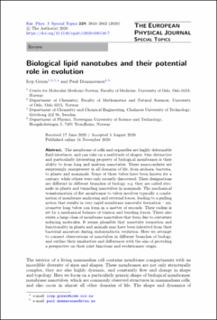| dc.contributor.author | Gözen, Irep | |
| dc.contributor.author | Dommersnes, Paul Gunnar | |
| dc.date.accessioned | 2021-02-12T12:55:57Z | |
| dc.date.available | 2021-02-12T12:55:57Z | |
| dc.date.created | 2021-01-10T17:28:17Z | |
| dc.date.issued | 2020 | |
| dc.identifier.citation | The European Physical Journal Special Topics. 2020, 229 (17-18), 2843-2862. | en_US |
| dc.identifier.issn | 1951-6355 | |
| dc.identifier.uri | https://hdl.handle.net/11250/2727782 | |
| dc.description.abstract | The membrane of cells and organelles are highly deformable fluid interfaces, and can take on a multitude of shapes. One distinctive and particularly interesting property of biological membranes is their ability to from long and uniform nanotubes. These nanoconduits are surprisingly omnipresent in all domains of life, from archaea, bacteria, to plants and mammals. Some of these tubes have been known for a century, while others were only recently discovered. Their designations are different in different branches of biology, e.g. they are called stromule in plants and tunneling nanotubes in mammals. The mechanical transformation of flat membranes to tubes involves typically a combination of membrane anchoring and external forces, leading to a pulling action that results in very rapid membrane nanotube formation – micrometer long tubes can form in a matter of seconds. Their radius is set by a mechanical balance of tension and bending forces. There also exists a large class of membrane nanotubes that form due to curvature inducing molecules. It seems plausible that nanotube formation and functionality in plants and animals may have been inherited from their bacterial ancestors during endosymbiotic evolution. Here we attempt to connect observations of nanotubes in different branches of biology, and outline their similarities and differences with the aim of providing a perspective on their joint functions and evolutionary origin. | en_US |
| dc.language.iso | eng | en_US |
| dc.publisher | Springer | en_US |
| dc.rights | Navngivelse 4.0 Internasjonal | * |
| dc.rights.uri | http://creativecommons.org/licenses/by/4.0/deed.no | * |
| dc.title | Biological lipid nanotubes and their potential role in evolution | en_US |
| dc.type | Peer reviewed | en_US |
| dc.type | Journal article | en_US |
| dc.description.version | publishedVersion | en_US |
| dc.source.pagenumber | 2843-2862 | en_US |
| dc.source.volume | 229 | en_US |
| dc.source.journal | The European Physical Journal Special Topics | en_US |
| dc.source.issue | 17-18 | en_US |
| dc.identifier.doi | 10.1140/epjst/e2020-000130-7 | |
| dc.identifier.cristin | 1868371 | |
| dc.relation.project | Norges forskningsråd: 187615 | en_US |
| dc.description.localcode | This is an open access article distributed under the terms of the Creative Commons Attribution License (https://creativecommons.org/licenses/by/4.0/), which permits unrestricted use, distribution, and reproduction in any medium, provided the original work is properly cited. | en_US |
| cristin.ispublished | true | |
| cristin.fulltext | original | |
| cristin.qualitycode | 1 | |

